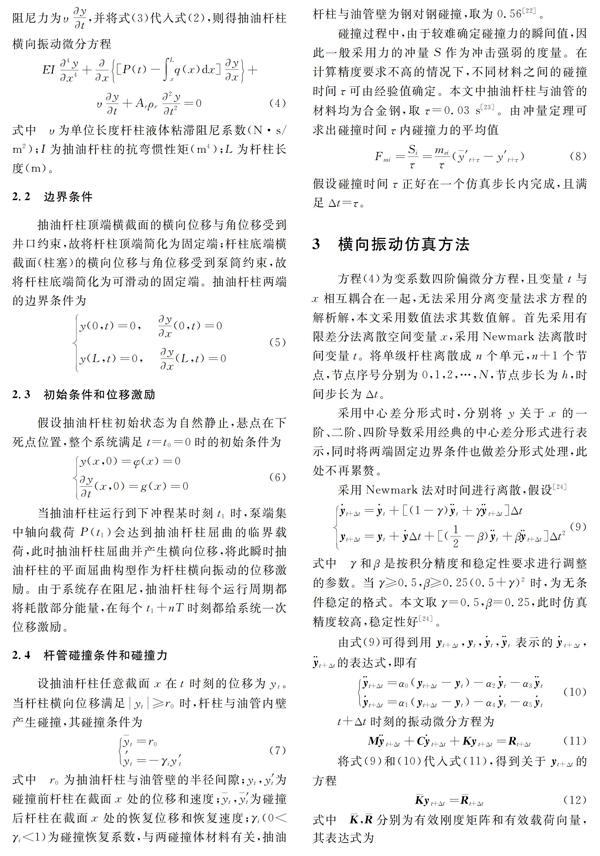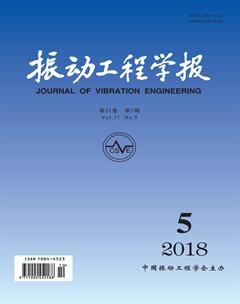直井抽油杆柱在屈曲位移激励下横向振动的仿真研究
孙秀荣 江少波 黄有泉



摘要: 鉴于目前直井杆管偏磨分析仅停留于抽油杆柱在油管内的静力屈曲理论,提出了一种基于抽油杆柱屈曲位移激励的抽油杆柱在油管内横向振动与杆管偏磨的动力学分析方法。考虑轴向分布载荷和泵端动载荷的作用,以下冲程某时刻抽油杆柱在油管内的屈曲构型作为抽油杆柱横向振动的位移激励,建立了直井抽油杆柱在油管内横向振动的仿真模型。采用有限差分法对井深进行离散,Newmark法对时间进行离散,以恢复系数法建立了杆管碰撞条件,碰撞冲量作为碰撞效果的度量,对抽油杆柱在油管内横向振动数学模型进行了数值仿真。仿真结果表明:杆管碰撞现象主要发生在下冲程杆柱发生屈曲后,且几乎沿全井都有发生,从井口至泵端附近的碰撞力峰值逐渐增大;中位点以下碰撞最强烈,碰撞力最大,且呈现高频次碰撞;中位点以上至井口附近,碰撞频次和碰撞力依次减弱;而上冲程碰撞现象很少,碰撞力也较小。所建立的抽油杆柱屈曲位移激励下的横向振动仿真模型适用于杆管偏磨分析,同时为扶正器的优化配置提供新的理论基础。
关键词: 横向振动; 抽油杆柱; 屈曲位移激励; 碰撞; 仿真模型
中图分类号: O327; TE933+.2 文献标志码: A 文章编号: 1004-4523(2018)05-0854-08
DOI:10.16385/j.cnki.issn.1004-4523.2018.05.015
引 言
现场统计结果表明,抽油杆柱在油管内的杆管偏磨现象是造成直井杆管故障以及油井检泵作业的主要原因。目前对直井杆管偏磨分析一直引用细长杆柱在圆筒内的静力屈曲力学理论[1-2]:杆柱底端受压载荷超过静力屈曲临界载荷时,杆柱产生屈曲并导致杆管接触产生偏磨;中位点以下的杆柱为受压杆柱[3-6],即为杆管的理论偏磨段。基于杆柱静力屈曲理论形成了直井杆管防偏磨扶正器配置优化设计方法[7-8]:在中位点以下配置扶正器;将相邻两扶正器之间的杆柱简化为铅直压杆,以该段压杆不屈曲(失稳)为条件设计扶正器配置间距。按上述方法设计扶正器配置方案虽然有效地预防或减轻了底部受压段杆管偏磨现象,但在实际油井中普遍出现了杆管偏磨明显上移现象。虽然底部抽油杆柱配置扶正器增加了抽油杆柱下行水力阻力,会导致杆柱中位点和杆管偏磨段上移,但根据实测悬点示功图最小载荷的变化幅度可以看出,实际偏磨段明显高于理论上的中位点。目前的抽油杆柱静力屈曲理论不能很好地解释直井这种杆管偏磨现象。
虽然底部抽油杆柱配置扶正器能有效预防或缓解直井底部杆管偏磨,但由于扶正器与油管内壁之间存在径向间隙,配置扶正器并不能预防抽油杆柱屈曲,配置扶正器后整体抽油杆柱实际上仍然处于屈曲状态,配置扶正器仅仅是改变了抽油杆柱的屈曲构型。显然,对直井抽油杆柱,无论是否配置扶正器,当抽油杆柱下行阻力大于抽油杆柱屈曲的临界载荷时,整体抽油杆柱都会处于屈曲状态,即抽油杆柱会产生横向位移。笔者认为,抽油杆柱屈曲横向位移激励抽油杆柱在油管内产生横向振动并与油管壁产生碰撞偏磨,中位点以下的杆管碰撞偏磨会较为严重,但中位点以上甚至全井都会产生杆管碰撞偏磨。当抽油杆柱底部配置扶正器后,中位点以上的碰撞点有可能成为新的薄弱点而产生偏磨甚至磨断现象。
国内外专家学者对工程中杆管柱动力学进行了大量研究。例如:文献[9-10]研究了杆柱的纵向振动;文献[11-12]研究了杆柱在横向外载荷激励下的振动问题;文献[13-15]研究了在端部纵向波动压力外载荷激励下杆管柱的横向振动;文献[16-20]研究了杆管柱在纵向振动(运动)、扭转振动影响下的横向振动,但到目前为止,基于屈曲位移激励下的铅直杆柱在圆筒内横向振动的研究并未见文献报道。另外,抽油杆柱所受的環境载荷与横向振动具有如下特点:(1)轴向分布载荷具有明显的非均匀分布特征;泵端集中轴向载荷为既有拉力又有压力,且以拉力为主的周期性变化载荷;(2)抽油杆柱横向振动被促发后与油管壁产生碰撞,碰撞点随时间发生变化。本文以杆柱屈曲位移为激励,建立抽油杆柱在油管内横向振动和碰撞的仿真方法,为深入研究直井杆管偏磨分析方法和扶正器配置优化设计方法提供理论依据。
1 抽油杆柱横向振动力学模型
为便于研究,做如下假设:
1) 抽油杆柱为弹性杆柱,杆柱轴心与井眼中心线重合。
2) 以井口为坐标原点,任意井深x处抽油杆柱的轴向分布载荷为 q(x)(N/m);抽油杆柱底端周期变化的集中轴向载荷为P(t)(N)。
3) 设抽油杆柱为均质单级杆,不考虑接箍和扶正器对杆柱局部弯曲刚度的影响。
4) 不考虑纵向振动和扭转振动对横向振动的影响。
5) 只给出杆柱在xoy平面内的位移激励,即只研究杆柱在该平面内的横向振动。
在上述假设条件下,建立图1(a)所示的抽油杆柱横向振动力学模型;屈曲位移示意图如图1(b)所示。在井深x处取dx段微元杆柱,微元受力如图1(c)所示。
轴向分布载荷q(x)由杆柱浮重、液体摩擦载荷、杆柱惯性与振动载荷等组成。杆柱底端集中轴向载荷P(t)与柱塞实际运动规律有关,同时杆柱底端轴向载荷P(t)又是抽油杆柱纵向振动的激励,因此抽油杆柱纵向振动仿真是轴向分布载荷q(x)、杆柱底端轴向载荷P(t)仿真的基础。采用式(1)所示的波动方程描述抽油杆柱的纵向振动[21]。由抽油杆柱纵向振动仿真结果便可以确定抽油杆柱的轴向分布载荷与杆柱底端集中轴向载荷[21]。
4.2 仿真结果分析
4.2.1 碰撞力变化规律
根据上述仿真模型,开发了抽油杆柱在屈曲位移激励下的横向振动仿真系统。图3,4绘出了前12个完整冲程,即180 s内碰撞力随井深和时间的变化规律。由图3可知:(1)碰撞力沿全井都有分布。在每个运动周期内,碰撞主要发生在下冲程,且抽油杆柱的碰撞力随井深的增加而增大,泵端附近的碰撞力最大。(2)碰撞力近似呈现周期性变化。各冲程碰撞力的波峰相差小于15%。由图4可知,中位点以下至泵端,碰撞频率高,且碰撞力幅值大;中位点以上至接近井口碰撞力幅值越来越小,碰撞频率也逐渐减弱。由图5进一步可知:(1)中位点以下碰撞最为剧烈;下冲程内,中位点以下的碰撞力明显高于中位点以上的碰撞力;(2)上冲程碰撞节点较少,碰撞力微弱;(3)中位点以下各冲程碰撞力峰值相差3%以内,振动规律具有明显的周期性。
综上说明,碰撞现象主要发生在下冲程,且全井杆柱都存在碰撞偏磨现象;中位点以下碰撞最为激烈,碰撞力较大;中位点以上至井口碰撞频率和碰撞力均逐渐减弱。上述仿真结果能够很好地解释实际油井中尽管中位点以下杆柱配置了扶正器,但杆管仍然存在偏磨的现象。这是因为虽然中位点以下杆柱配置扶正器可有效地预防或减轻底部受压段杆管的偏磨现象,但由于整体抽油杆柱仍然存在屈曲位移(由于扶正器与油管壁存在间隙,配置扶正器仅仅是降低了杆柱屈曲位移的幅值),中位点以上杆管仍然存在碰撞偏磨,并有可能成为新的偏磨薄弱点而发生严重偏磨现象。
4.2.2 横向振动规律
图6~8分别得到了不同井深和不同时刻杆柱的横向振动规律。由图6可知,下冲程内,碰撞频次较多,沿全井几乎都产生杆管横向碰撞,且随井深的增加,杆柱触碰油管壁的时间间隔越来越小,次数越来越多,说明下冲程随井深的增加杆管碰撞频率越来越高,碰撞现象越来越激烈。由图6可看出上冲程杆管碰撞较轻。图7和8上下冲程杆柱横向振动规律的对比进一步说明下冲程碰撞现象剧烈,而上冲程碰撞现象则大大减弱。
5 结 论
(1) 建立了平面下抽油杆柱在油管内横向振动模型,采用有限差分法和Newmark法综合计算,充分考虑杆管间的碰撞效应,实现了对直井系统横向振动下杆管碰撞的非线性动力学的仿真。
(2) 横向振动导致杆管碰撞的现象几乎沿全井都有分布。中位点以下呈现高频次高碰撞力,中位点以上至井口附近,碰撞频次依次减弱。
(3) 一个运动周期内,杆管碰撞现象主要发生在下冲程杆柱发生屈曲后,其碰撞频率高,碰撞力也大;而上冲程碰撞现象很少,碰撞力也很小。
(4) 通过分析杆柱在油管内的横向振动和碰撞规律,对直井杆管偏磨机理与偏磨位置有了新的认识:直井杆管偏磨不仅仅发生于中位点以下的受压段杆柱,而且也会发生于中位点以上的受拉段杆柱;中位点以下抽油杆柱配置扶正器可有效地预防或减轻底部受压段杆管偏磨现象,但由于整体抽油杆柱仍然存在屈曲位移,中位点以上杆管仍然存在碰撞偏磨,并有可能因为没有扶正器的保护而成为新的薄弱点,进而产生严重偏磨、甚至磨断。上述理论认识与工程实际相符。
(5) 所建立的抽油杆柱屈曲位移激励下的横向振动仿真模型可进一步应用于杆管偏磨分析,同时为扶正器的优化配置提供新的理论基础,对此有待深入研究。
参考文献:
[1] Lubinski A. A study of the buckling of rotary drilling string [J]. Drilling and Production Practice, 1950: 178—214.
[2] Huang W J, Gao D L, Liu Y H. A study of tubular string buckling in vertical wells [J]. International Journal of Mechanical Sciences, 2016, 118: 231—253.
[3] 董世民. 水驱抽油机井杆管偏磨原因的力学分析 [J]. 石油学报, 2003, 24(4): 108—112.
Dong Shimin. Mechanical analysis on causes of worn rod string and tubing of rod pumping wells in the water-flooding oilfield [J]. Acta Petrolei Sinica, 2003, 24(4): 108—112.
[4] Jin H, Zhang J, Zhang Y Y. Mechanism and control of eccentric wear of sucker rod [J]. Applied Mechanics & Materials, 2014, 528: 232—236.
[5] Nurmohamed D, Lien H, Chin A, et al. Case study for reducing tubing failures in Suriname′s Tambaredjo field [C]. Trinidad and Tobago Energy Resources Conference, Port of Spain, Trinidad and Tobago, 2014: 667—681.
[6] 劉 合, 郝忠献, 王连刚, 等. 人工举升技术现状与发展趋势 [J]. 石油学报, 2015, 36(11): 1441—1448.
Liu He, Hao Zhongxian, Wang Liangang, et al. Current technical status and development trend of artificial lift[J]. Acta Petrolei Sinica, 2015, 36(11): 1441—1448.
[7] Juvkam-Wold H C, Wu J. Casing deflection and centralizer spacing calculations [J]. SPE Drilling Engineering, 1992, 7(4): 268—274.
[8] 史楠楠, 李军强. 直井抽油杆柱扶正器安装间距设计计算 [J]. 石油钻探技术, 2007, 35(2): 59—61.
Shi Nannan, Li Junqiang. Design and computation for installing interval between centralizers of sucker-rod strings in vertical wells [J]. Petroleum Drilling Techniques, 2007, 35(2): 59—61.
[9] Xing M M, Dong S M. An improved longitudinal vibration model and dynamic characteristic of sucker rod string [J]. Journal of Vibroengineering, 2014, 16(7): 3432—3448.
[10] Shokrollahi M, Nejad A Z B. Numerical analysis of free longitudinal vibration of nonuniform rods: Discrete singular convolution approach [J]. Journal of Engineering Mechanics, 2014, 140(8): 06014007.
[11] 趙伟东, 杨亚平, 李秀莲, 等. 简谐干扰力作用的弹性基础上压杆的横向振动与屈曲 [J]. 应用力学学报, 2015, 32(4): 642—646+708.
Zhao Weidong, Yang Yaping, Li Xiulian, et al. The transverse vibration and buckling of a compressive bar on elastic foundation subjected to harmonic excitation [J]. Chinese Journal of Applied Mechanics, 2015, 32(4): 642—646+708.
[12] Li Z F, Wang P, Zhao M, et al. Transverse vibration analysis of the riser in deep water [J]. Source: Open Petroleum Engineering Journal, 2015, 8(1): 38—44.
[13] Morozov N F, Tovstik P E. Transverse rod vibrations under a short-term longitudinal impact [J]. Doklady Physics, 2013, 58(9): 387—391.
[14] Blevins R D, Coughran C S, Utt M E, et al. Drilling-induced riser vibration[J]. International Journal of Offshore and Polar Engineering, 2017, 27(3): 232—238.
[15] 祝效华, 胡志强. 基于钻头破岩钻进的下部钻具横向振动特性研究 [J]. 振动与冲击, 2014, 33(17): 90—93.
Zhu Xiaohua, Hu Zhiqiang. Lateral vibration characteristics analysis of a bottom hole assembly based on interaction between bit and rock [J]. Journal of Vibration and Shock, 2014, 33(17): 90—93.
[16] Kiani K. Longitudinally varying magnetic field influenced transverse vibration of embedded double-walled carbon nanotubes [J]. International Journal of Mechanical Sciences, 2014, 87(4) :179—199.
[17] Thalapil J, Maiti S K. Analysis of coupled transverse and axial vibrations of Euler Bernoulli and Timoshenko beams with longitudinal crack for its detection [J]. Mechanisms and Machine Science, 2015, 23 :433—448.
[18] Malaeke H, Moeenfard H, Ghasemi A H. Nonlinear coupled transverse and axial vibration of variable cross-section beam flexures interconnecting rigid body [C]. ASME 2016 Dynamic Systems and Control Conference, Minneapolis, USA, 2016.
[19] Duan Y C, Wang J P, Wang J Q, et al. Theoretical and experimental study on the transverse vibration properties of an axially moving nested cantilever beam [J]. Journal of Sound and Vibration, 2014, 13: 2885—2897.
[20] Makkar N, Sullivan E, Habernal J. Coupling between lateral and torsional vibrations: A new insight into pdc bit drilling inefficiencies [C]. Offshore Technology Conference, Kuala Lumpur, Malaysia, 2014, 4: 3180—3190.
[21] 董世民. 抽油机井动态参数计算机仿真与系统优化 [M]. 北京:石油工业出版社, 2003.
Dong Shimin. Computer Simulation of Dynamic Parameters of Rod Pumping System Optimization [M]. Beijing:Petroleum Industry Press, 2003.
[22] 祝效华, 童 华, 刘清友, 等. 旋转钻柱与井壁的碰撞摩擦边界问题研究 [J]. 中国机械工程, 2007, 18(15): 1833—1837.
Zhu Xiaohua, Tong Hua, Liu Qingyou, et al. Research on the dynamic boundary condition between revolving drill string and borehole wall [J]. China Mechanical Engineering, 2007, 18(15): 1833—1837.
[23] 宋晓华, 李 伟. 材料特性对转向柱碰撞性能影响的仿真研究 [J]. 重庆交通大学学报(自然科学版), 2012, 31(4): 866—868.
Song Xiaohua, Li Wei. Crashworthiness numerical simulation of material properties on vehicle steering mast [J]. Journal of Chongqing Jiaotong University (Natural Science), 2012, 31(4): 866—868.
[24] 王海波, 陈伯望, 余志武. 结构动力方程Newmark-β方法递推简化分析 [J]. 四川大学学报(工程科学版), 2008, 40(3): 47—52.
Wang H B, Chen B W, Yu Z W. A simplified numerical integration format of Newmark-β method for structural dynamic equations [J]. Journal of Sichuan University (Engineering Science Edition), 2008, 40(3): 47—52.
Abstract: Considering the limitations of the static buckling theory on the eccentric wear between the sucker rod and the tube, a dynamic analysis method for the study of the transverse vibration of the sucker rod in the tube is proposed. Taking the axial distributed load and the dynamic load at the pump head, the dynamic model of the transverse vibration is established based on the buckling configuration of the rod string which is regarded as the deformation excitation during the down stroke. To solve the equation, the finite difference method is used to discretize the well depth and the Newmark method is used to discretize the time. Meanwhile, a restitution coefficient is introduced to build the collision condition, and the impact momentum is measured and taken as the collision strength. The result shows that the phenomenon of rod-tubing collision occurs mainly in the down stroke after the post buckling of the rod string, and the collision force, which distributed almost along the entire well depth, will increase gradually from the wellhead to the bottom. It also shows that the high frequency collision occurs below the neutral point where the collision force takes the largest value. Furthermore, the collision frequency and the collision force decrease successively along the direction from the neutral point to the wellhead. On the other hand during the up stroke, few collisions occur and the collision force is also very small. The simulation model is suitable for the eccentric wear analysis of rod-tubing and provides a new theoretical basis for the optimal allocation of the centralizer.
Key words: transverse vibration; sucker rod string; bucking deformation excitation; collision; simulation model
作者簡介: 孙秀荣(1984-),女,博士研究生。电话:13513343996;E-mail: sunxiurong84@163.com
通讯作者: 董世民(1962-),男,博士生导师,教授。电话:13833575208;E-mail: ysudshm@163.com

